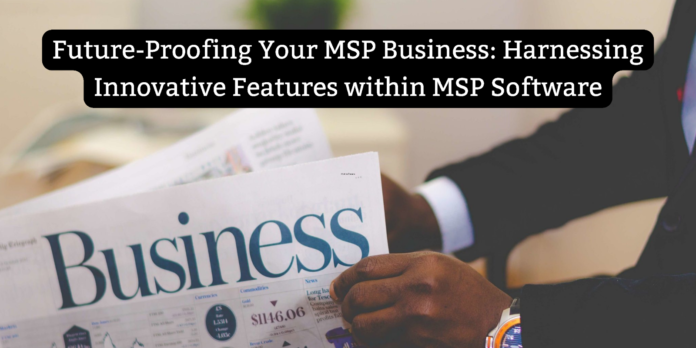The managed service provider (MSP) industry is undergoing rapid evolution. With emerging technologies, escalating cyberthreats, and shifting client expectations, MSPs face pressure to keep pace and remain competitive. This article explores how harnessing innovative software can future-proof MSP businesses to capitalize on industry growth opportunities. It provides an overview of key software capabilities in areas like analytics, cloud management, and security that enable MSPs to boost efficiency, improve customer retention, and support advanced services. We’ll discuss implementation challenges that can hinder adoption of new features and proven strategies to drive change management for long-term success. Equipped with cutting-edge software and a culture of innovation, MSPs can transform their operations to meet demands now and in the future.
Key Innovative Features in Modern MSP Software
Cutting-edge MSP software platforms offer:
Predictive Analytics Capabilities
Predictive analytics uses statistical modeling and machine learning algorithms to analyze system data. It identifies usage patterns and anticipates potential issues before they cause outages. Key features include:
Proactive Infrastructure Monitoring
- Track metrics across servers, networks and devices.
- Get alerts for indicators like high CPU usage or error rates.
- Fix impending issues before they impact users.
Automated Anomaly Detection
- Machine learning models profile normal performance baselines.
- Intelligent algorithms spotlight anomalies in real time.
- Focus efforts on suspicious events vs chasing false positives.
Continuous Performance Optimization
- Receive recommendations to tune infrastructure health.
- Identify outdated hardware nearing end of life replacement cycles.
- Rightsize workloads across cloud and on-prem resources.
Robust Cloud Management Capabilities
As cloud adoption accelerates, MSP software must provide centralized visibility, flexible controls, and cost oversight across cloud environments.
Unified Cloud Dashboards
- Get single pane-of-glass views spanning many cloud providers.
- Visualize usage, performance and spending trends.
- Ensure adherence to budget guardrails and policies.
Simplified Provisioning & Scaling
- Automate adding or removing cloud resources on-demand to match usage needs.
- Align storage, compute and memory to application workloads.
- Avoid overprovisioning to reduce expenses.
Cost Optimization & Governance
- Rightsize workloads by reallocating underutilized instances.
- Enforce tag policies and budget alerts.
- Schedule resources to stop outside business hours.
Advanced, Integrated Security
Breaches are happening more often and having bigger effects. MSPs need to set up layered security that covers endpoints, networks, data, and users.
Unified Threat Monitoring & Response
- Collect event data from endpoints, email, firewalls, VPNs etc.
- Analyze across vectors to identify coordinated attacks.
- Remediate threats faster with centralized workflows.
Continuous Compliance Auditing
- Automate assessments for HIPAA, PCI DSS, ISO 27001 etc.
- Enforce controls like multi-factor authentication.
- Simplify audits and reporting for clients.
Granular Access Governance
- Define role-based access policies per user groups.
- Audit permission changes and online activity.
- Provision/deprovision employee credentials.
The Benefits of Harnessing Innovation
By leveraging such innovative capabilities, MSPs can:
Increase Operational Efficiency
- Automate repetitive manual processes with RPA bots.
- Merge tools into unified platforms.
- Let algorithms handle day-to-day infrastructure optimization.
Improve Customer Satisfaction
- Delight clients with smoother-running systems.
- Align cloud infrastructure to evolving business needs.
- Provide executive reporting and recommendations.
Keep More Clients Long-Term
- Reduce security incidents through multilayered protection.
- Ensure compliance safety nets are in place.
- Make it easier to stay with existing MSP vs switch.
Overcoming Implementation Challenges
Adopting new software capabilities can be challenging:
Internal Resistance to Change
Some staff may oppose changing existing systems and processes.
Drivers of Resistance
- Fear of job loss from automation.
- Lack proper training to use new features.
- Concern about slowed productivity during transition.
Strategies to Overcome Resistance
- Provide training on the benefits of new features.
- Incentivize staff to get certified in utilizing the software.
- Phase-in implementation to ease the transition.
Feature Overload
The breadth of capabilities may seem overwhelming. Trying to adopt everything at once reduces focus and ROI.
Key Challenges
- IT teams get distracted from core objectives.
- Rollout delays due to unclear priority.
- Underutilization of capabilities purchased.
Strategies to Overcome Overload
- Focus on rolling out the highest value features first.
- Leverage vendor implementation guidance.
- Start with non-critical infrastructure/clients as test cases.
The Roadmap to an Innovation-Driven MSP
Harnessing software innovations involves:
Continuous Learning
- Dedicate monthly time for teams to research technology trends.
- Have quarterly strategy meetings on market direction.
- Attend conferences and workshops to skill up.
Phased Integration
- Catalog all new platform capabilities available.
- Map rollout plan to goals over 12-18 months.
- Take an agile, iterative approach to enable innovation.
Specialized Talent
- Assess current skills gaps inhibiting adoption.
- Develop or recruit staff literate in key areas like cloud, security, analytics.
Process Alignment
- Evolve service delivery model and SLAs to leverage capabilities.
- Refine account management approach to guide clients on innovations.
- Incentivize cross-selling of new intelligent services.
By future-proofing MSP operations in this manner, software stops causing disruption. Instead, it fuels business growth and competitive differentiation.
FAQs
What are the key software selection criteria for MSPs today?
The top considerations span: The client needs alignment. It should match current and emerging needs around security, compliance, cloud, and automation.
Ease of Integration & Usage: Choose platforms with open APIs, top usability scores.
ROI Potential: Focus on capabilities that maximize revenue growth, efficiency gains, and retention.
Competitive Differentiation: Opt for advanced, cutting-edge features that set your MSP apart.
How can MSPs ease smooth software implementation?
Best practices for ensuring successful rollouts include:
- Confirm all technical prerequisites early.
- Shadow vendor professional services sessions.
- Define policies guiding usage of new capabilities.
- Start testing on non-essential clients or infrastructure first.
What success stories showcase software innovation transforming MSP businesses?
Top MSP platforms, like ConnectWise, NinjaRMM, Datto Autotask, and Microsoft 365, enable thousands of MSPs to expand service catalogs, increase efficiency, and grow. They do this through cutting-edge capabilities around cloud management, security services, automation, predictive analytics, and more.
Key Takeaways on Future-Proofing Your MSP with Innovative Software
- Ongoing technology shifts around cyber threats, cloud adoption, and analytics are creating challenges and opportunities for MSPs.
- Innovative software features can help overcome these industry trends by improving efficiency, client satisfaction, and retention rates.
- Predictive analytics, robust cloud management, and advanced security currently drive the most value for MSPs.
- Some change management hurdles exist. But, following structured roadmaps for capability integration yields transformational upside.
- MSPs that fail to future-proof via software innovation risk falling behind long-term.
MSP leaders can use these insights to chart a course towards leveraging technology. In the years ahead, they can unlock efficiency, growth, and competitive differentiation for their businesses. The time to start this future-proofing journey is now.





